Wortley, West Riding of Yorkshire
Up to 1834
A parliamentary report of 1777 recorded local workhouses in operation at Wortley (for up to 35 inmates), Bradfield (60), and Ecclesfield (60). (Note that the Wortley referred to on this page lies between Sheffield and Barnsley, and should not be confused with the district in Leeds of the same name.)
The Wortley workhouse was at Finkel (now Finkle) Street to the south-west of the Wortley, in a row of cottages now known as Laundry Row.
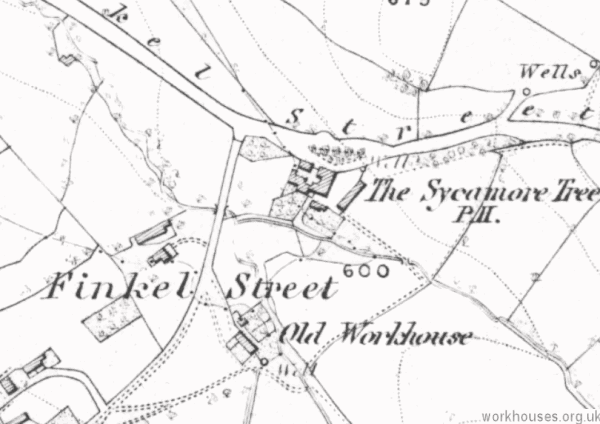
Wortley Finkle Street site, 1855.
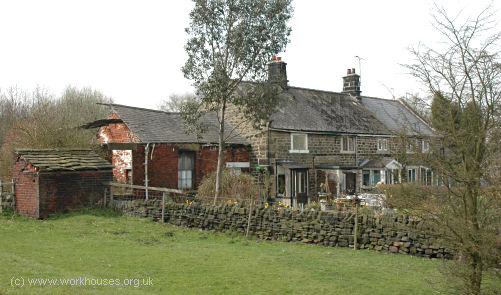
Wortley Finkle Street workhouse from the east from the south-east, 2006.
© Peter Higginbotham.
Bradfield's workhouse, dating from about 1760, was in a row of houses on Towngate in Upper (or High) Bradfield.
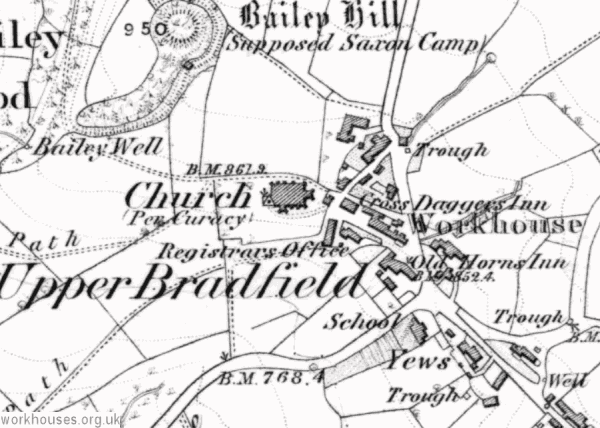
Wortley Bradfield site, 1855.
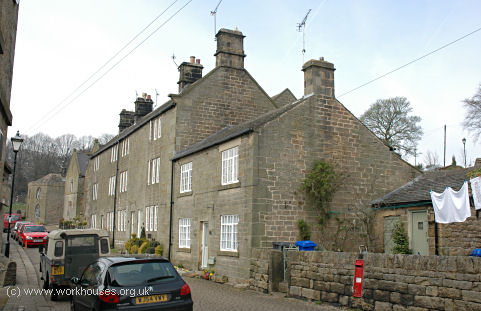
Wortley Bradfield workhouse, 2006.
© Peter Higginbotham.
In the 1730s, Ecclesfield erected a workhouse in a building on the site of former almshouses at the west of St Mary's Lane. The building, which was known as Feoffees Hall, was later a school, then after 1894 housed the Parish Council offices, finally being used as British Legion premises until its demolition in around 1968.
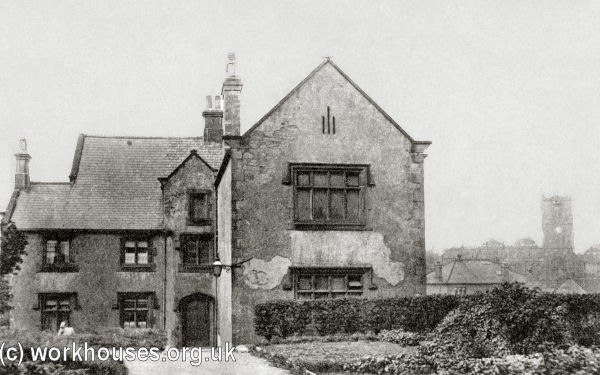
Ecclesfield Feoffees House, date unknown.
Eden, in his 1797 survey of the poor in England, reported of Ecclesfield that:
Bill of fare : Breakfast—every day, milk pottage and bread. Dinner—Sunday, Wednesday, butcher's meat, potatoes, broth and bread ; Monday, Thursday, bread and 2oz. butter ; other days, puddings with sauce and beer. Supper—Sunday, Wednesday, broth and bread ; other days, milk pottage and bread. Oatbread is generally used, sometimes wheaten bread. One certificate and one removal in a year.
Another workhouse is thought to have stood on Bower Lane at Grenoside.
After 1834
Wortley Poor Law Union was formed on 21st August 1838. Its operation was overseen by an elected Board of Guardians, 20 in number, representing its 12 constituent parishes as listed below (figures in brackets indicate numbers of Guardians if more than one):
West Riding of Yorkshire:
Bradfield (3), Ecclesfield (4), Hoyland Swaine, Hunshelf, Langset, Ingbirchworth, Oxspring, Penistone, Tankersley, Thurgoland (2), Thurlstone (2), Wortley (2).
Later Addition:
Stocksbridge (from 1849).
Initially, the Wortley Union continued to use existing workhouses at Ecclesfield and Bradfield.
In 1849, a new Penistone Union was created which included most of the original member parishes of the Wortley Union, leaving just Bradfield, Ecclesfield, Tankersley, and Wortley, together with the newly acquired Stocksbridge.
The population falling within the Union at the 1831 census had been 23,713 with parishes ranging in size from Oxspring (population 283) to Ecclesfield (7,911).
In 1839, Wortley was one of the Unions which the Poor Law Commissioners reported as which "for the present decline to concur in providing an adequate Workhouse". However, the existing township workhouses appear to have continued in use.
In 1850-52, a new union workhouse was built on Salt Box Lane at Grenoside, with Aicken and Capes as architects. The main block had a cruciform layout with Master's quarters and dining-hall at the north, male accommodation at the west, and female at the east. A hospital block was added at the north-west of the site and a porters' lodge and board-room at the north facing onto the road. A casuals' block and labour yard were placed opposite the workhouse at the north side of Salt Box Lane. The site location and layout are shown on the 1905 map below.
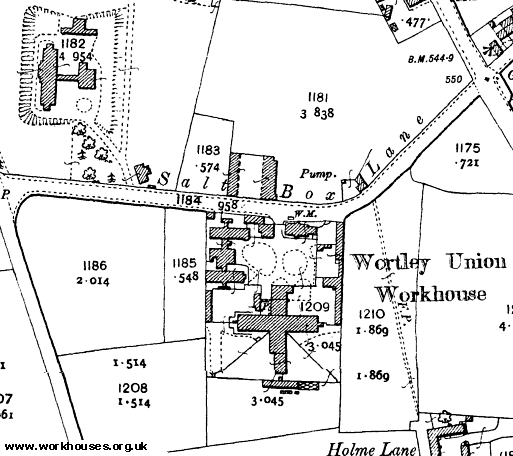
Wortley Salt Box Lane site, 1905.
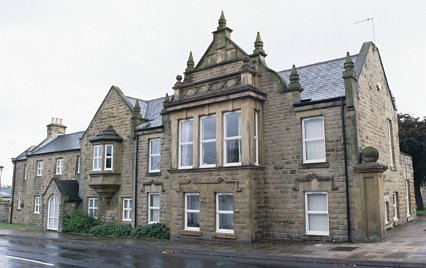
Wortley entrance/board-room block from the north, 2001.
© Peter Higginbotham.
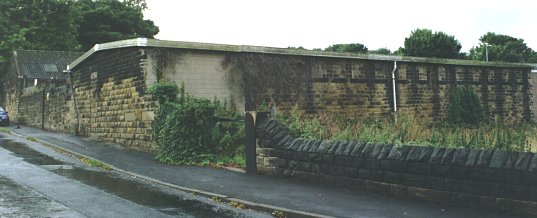
Wortley casuals' block from the south-east, 2001.
© Peter Higginbotham.
In 1930, the workhouse was taken over by the West Riding County Council. A Council report at that date described the institution as "badly planned, difficult to work, in bad repair, and the accommodation for staff is most unsatisfactory. The floors, eaves, gutters, sanitary fittings, and paint work are deplorable. There is no central heating or central hot water scheme, the hot water for baths being in most cases from gas geysers." The buildings at this date were all lit by gas which, in many cases, was said to be "inadequate". The casual ward had been closed and was occupied by the union's Relieving Officer. It was strongly recommended that a completely new and modern institution be be built. A plan of the site made in 1930 shows, in addition to the buildings, an extensive kitchen garden, a greenhouse, cold frames, and piggeries.
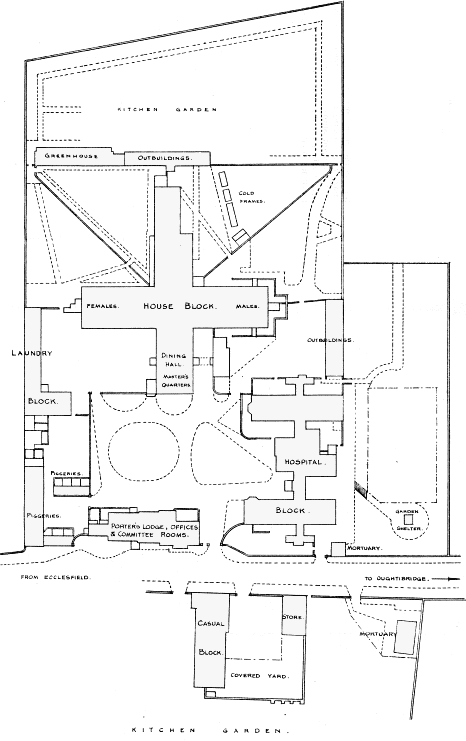
Wortley site plan, 1930.
In fact, the old buildings continued in use for another half a century. From 1930, the site became Grenoside County Welfare Institution and provided accommodation for what were then termed "mental defectives" . It was due to be closed in 1940, but with the onset of the Second World War was kept open with 44 beds. In 1949, the nearby infectious diseases hospital became an annexe to the Institution, and by 1956 the two sites could house a total of 182 patients. In 1957, the combined establishment became known as Grenoside Hospital. By 1971, there was accommodation for 208 patients, with men placed in the former workhouse buildings, and women across the road in the annexe. The main workhouse block was then described as "a Dickensian workhouse which remains a grim, dark inconvenient Victorian building... activities go on despite the lack of any real facilities." The hospital finally closed in 1989.
The site is now used for residential care accommodation and virtually all the old buildings have now been demolished. The former casuals' block and labour yard survived until 2003 but are now also gone. The entrance block is all that now remains of the workhouse era.
Staff
Inmates
Records
Note: many repositories impose a closure period of up to 100 years for records identifying individuals. Before travelling a long distance, always check that the records you want to consult will be available.
- Sheffield Archives, 52 Shoreham Street, Sheffield S1 4SP. Relatively few records survive — holdings include: Guardians' minutes (1838-1929); Various committee minutes.
Bibliography
- Diver, D & Howsam, L (2010) Life in the Grenoside Workhouse [Volume 5 of the series Round and About Grenoside]. Availabe to purchase at £4.95 plus £1.25 P&P UK - Cheques payable to Grenoside & District Local History Group and posted c/o 8 Far View Road, Sheffield Lane Top, Sheffield, S5 7TB.
Links
- Ripon Workhouse Museum and Garden, Sharow View, Allhallowgate, Ripon HG4 1LE.
Unless otherwise indicated, this page () is copyright Peter Higginbotham. Contents may not be reproduced without permission.


